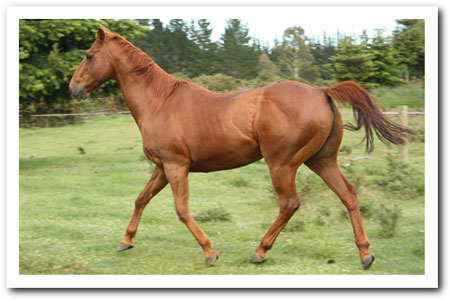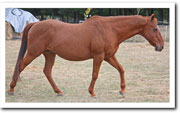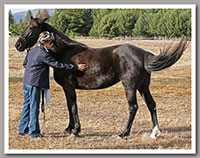About Musculo-skeletal Disorders
- Muscle Soreness
- Girthy, cold-backed
- Tight ham-strings, can’t track up, choppy and short-stepping
- Sacro-iliac problems, trouble with the canter, bunny-hopping, swapping leads
- Hollow posture
- Trouble with saddle fitting
- Locking Stifles
These are often mis-diagnosed. They seem like physical problems but more often than not, turn out to be physiological ( chemistry) problems.
When the horse is subjected to chronic mineral imbalances from consuming too much vegetative grass, the functioning of the nervous system is compromised. You will see nervous disorders and since the nerves tell the muscles what to do there is an adverse effect on muscle function as well.
WHAT WOULD YOU THINK THE PROBLEM IS HERE?
First thoughts may be that this horse has injured himself in some way, or had some kind of musculo-skeletal malfunction affecting the sacro-iliac area!
However, this is actually a very good example of what 'bio-chemistry' problems can look like.
This horse has kept been on a dry lot for most of the year as he has been a head-flicker. He had been moving perfectly UNTIL we saw him consuming all the little green shoots (seen in video) that had suddenly sprouted after a deluge of rain a week or so ago.
You can see the improvement he made within three days.
It is hard to believe how such a small amount of new clover shoots could have such a dramatic effect but with horses like Lochy, who are very sensitive this is exactly what can happen.
Take Persil Beaucoup...
The picture top right is Persil - although he had been on the Premium Minerals for some weeks and his body condition had improved vastly, he is still ‘not right’ – he exhibits the ‘hollow posture’, is tight behind, his back is stiff, there is no tracking up, his neck looks short and braced so his head is up and he is not relaxed...
Persil was seen by various 'experts' from vets to farriers to chiropractors but nothing made any difference UNTIL he was moved off the rich grass he was on and onto 'crap grass'and we added GrazeEzy to his feed.
 What a difference!
What a difference!
If your horse has had some kind of an accident or is working pretty hard as an athlete then he may have an actual physical problem. But often these issues arise for no apparent reason, even when the horse has been turned out and doing no work whatsoever.
It is imperative to include diet as a possible cause otherwise you can spend a lot of money on treatments which only provide temporary relief rather than complete recovery.
Bad hands or 'Grass-Affected'?

Looking at this picture, most people would blame the rider and say she has bad hands but this is also the typical posture of the ‘grass-affected’ horse.
The head flies up and they hollow out. This causes the rider to pull on the reins in an attempt to stop the horse from running off.
So there are two problems going on here and both need to be addressed to help the poor horse.
Muscle Twitching
One of the signs of being ‘grass-affected’ is the horse’s skin being ‘twitchy’ as demonstrated in the video clip attached.

Click for Video of twitchy horse
This lovely little horse is EXTREMELY twitchy. Most aren’t as bad as this.
When you are checking your horse out make sure you have a halter on and keep the horse’s head towards you – then touch the horse on his side, flank or wither area. You will soon see if he twitches or quivers. (Note this is not how you would normally touch your horse)
Sometimes the horse will shy away and not want to be touched at all let alone be brushed or girthed up.
Being twitchy or hyper-sensitive means some diet adjustments are advisable to make your horse more comfortable..
Some people might ‘get to work’ to ‘desensitise’ the horse when it is not behavioural but a chemistry problem.
Hypersensitivity in horses can also be seen (and felt) with swishing tails, general irritability, inability to tolerate leg aids, a feeling of general resistance, inability to bend on a circle and wanting to run off with their head in the air.
(Go to your local A&P show and take a look at the Hack ring – you’ll see plenty of these horses).
People try to ‘ride their horses through it’ which is a mistake because it is nearly always NOT behavioural but rather a physiological or a ‘chemistry’ problem.
If you are encountering any of these issues with your horse it is best to first look to his diet.
The new spring grass growth is the major culprit, compounded by high potassium feeds such as Lucerne, protein meals (soya bean meal), molassed feeds and kelp.
Make sure the horse is getting enough salt in his feed.
More Details
How on earth could these be diet related issues?
Very, very easily! The delicate internal balances of the electrolytes (minerals dissolved in the blood and body fluid that carry an electrical charge ie calcium, magnesium, sodium, potassium and chloride) are responsible for generating nerve impulses and telling the muscles what to do.
When the electrolytes are out of balance the muscles cannot work properly and they can become inflamed and/or swollen, the horse will naturally be agitated, unable to move properly let alone perform, and even the best fitting saddle will cause major discomfort.
In the instances when blood tests have been run, they show high potassium, sometimes low sodium and high muscle enzymes.
Creatine kinase, or CK, is a type of enzyme found in your muscles which aids in the production of energy. CK is normally found inside your muscle cells, but inflammation of these muscle cells can cause CK to leak into the bloodstream and cause the CK (or CPK) reading to be high.
Thermograph or heat sensitive pictures show inflammation of the muscles (myositis). If it does turn out that these conditions are caused by the horse’s diet then they can be relatively easily remedied.
Take the Recommended Steps to drop the potassium content of your horse’s diet and ensure adequate levels of the other electrolytes. Depending on the grass, you may or may not have to remove the horse from it but it will be absolutely necessary for now, to eliminate lucerne, clover, molassesed grains, kelp and protein meals.
Read Mineral Imbalances in the Grass Caused Inflammation in the Horse
 Calm Healthy Horses
Calm Healthy Horses